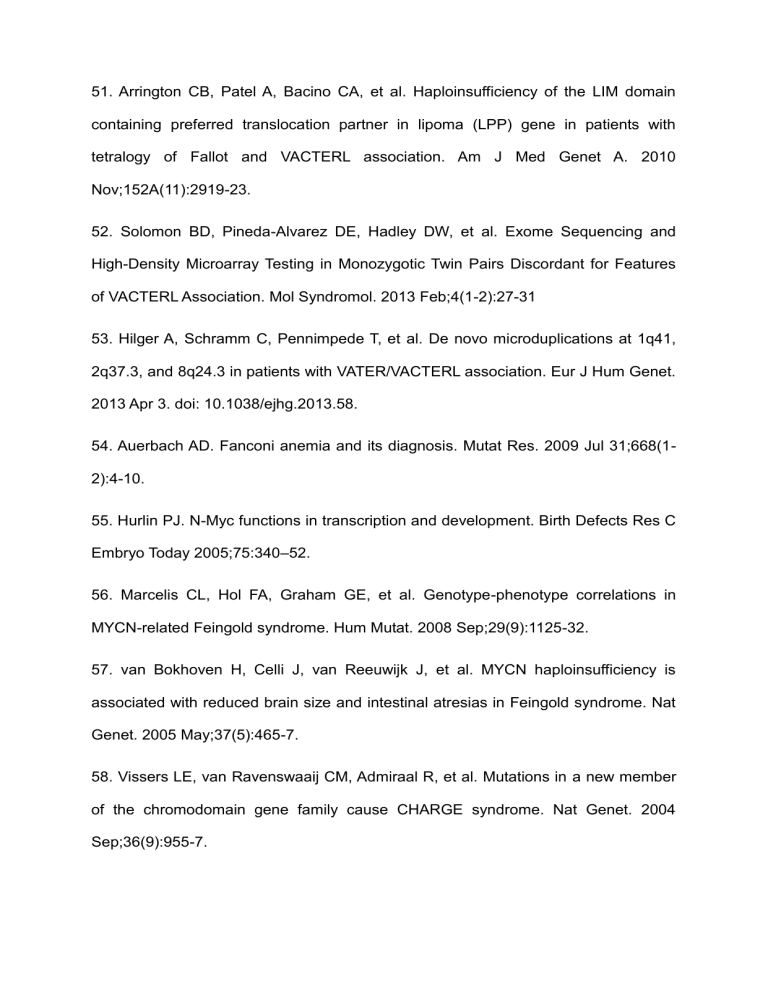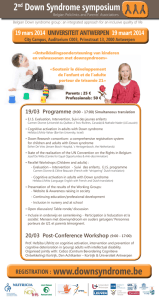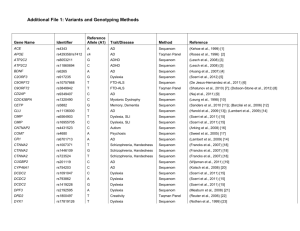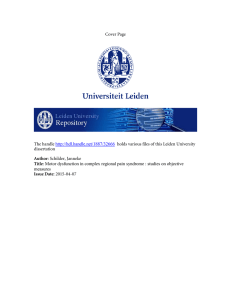51. Arrington CB, Patel A, Bacino CA, et al. Haploinsufficiency of the

51. Arrington CB, Patel A, Bacino CA, et al. Haploinsufficiency of the LIM domain containing preferred translocation partner in lipoma (LPP) gene in patients with tetralogy of Fallot and VACTERL association. Am J Med Genet A. 2010
Nov;152A(11):2919-23.
52. Solomon BD, Pineda-Alvarez DE, Hadley DW, et al. Exome Sequencing and
High-Density Microarray Testing in Monozygotic Twin Pairs Discordant for Features of VACTERL Association. Mol Syndromol. 2013 Feb;4(1-2):27-31
53. Hilger A, Schramm C, Pennimpede T, et al. De novo microduplications at 1q41,
2q37.3, and 8q24.3 in patients with VATER/VACTERL association. Eur J Hum Genet.
2013 Apr 3. doi: 10.1038/ejhg.2013.58.
54. Auerbach AD. Fanconi anemia and its diagnosis. Mutat Res. 2009 Jul 31;668(1-
2):4-10.
55. Hurlin PJ. N-Myc functions in transcription and development. Birth Defects Res C
Embryo Today 2005;75:340 –52.
56. Marcelis CL, Hol FA, Graham GE, et al. Genotype-phenotype correlations in
MYCN-related Feingold syndrome. Hum Mutat. 2008 Sep;29(9):1125-32.
57. van Bokhoven H, Celli J, van Reeuwijk J, et al. MYCN haploinsufficiency is associated with reduced brain size and intestinal atresias in Feingold syndrome. Nat
Genet. 2005 May;37(5):465-7.
58. Vissers LE, van Ravenswaaij CM, Admiraal R, et al. Mutations in a new member of the chromodomain gene family cause CHARGE syndrome. Nat Genet. 2004
Sep;36(9):955-7.
59. Engelen, E., Akinci, U., Bryne, J. C., et al. Sox2 cooperates with Chd7 to regulate genes that are mutated in human syndromes. Nature Genet. 2011 43: 607-611.
60. Williamson, K. A., Hever, A. M., Rainger, J., et al. Mutations in SOX2 cause anophthalmia-esophageal-genital (AEG) syndrome. Hum. Molec. Genet. 15: 1413-
1422, 2006. Note: Erratum: Hum. Molec. Genet. 15: 2030 only, 2006.
61. Bednarczyk, D., Smigiel, R., Patkowski, D., et al. Normal exon copy number of the GLI2 and GLI3 genes in patients with esophageal atresia. Dis Esophagus. 2013
Feb 26. doi: 10.1111/dote.12036.
62. De Falco F, Cainarca S, Andolfi G, et al. X-linked Opitz syndrome: novel mutations in the MID1 gene and redefinition of the clinical spectrum. Am J Med Genet
A. 2003 Jul 15;120A(2):222-8.
63. Gordon CT, Petit F, Oufadem M, et al. EFTUD2 haploinsufficiency leads to syndromic oesophageal atresia. J Med Genet. 2012 Dec;49(12):737-46
64. Jongmans MC, Admiraal RJ, van der Donk KP, et al. CHARGE syndrome: the phenotypic spectrum of mutations in the CHD7 gene. J Med Genet. 2006
Apr;43(4):306-14.
65. So J, Suckow V, Kijas Z, et al. Mild phenotypes in a series of patients with Opitz
GBBB syndrome with MID1 mutations. Am J Med Genet A. 2005 Jan 1;132A(1):1-7
66. Winter J, Lehmann T, Suckow V, et al. Duplication of the MID1 first exon in a patient with Opitz G/BBB syndrome. Hum Genet. 2003 Mar;112(3):249-54
67. Zenteno JC, Perez-Cano HJ, Aguinaga M. Anophthalmia-esophageal atresia syndrome caused by an SOX2 gene deletion in monozygotic twin brothers with
markedly discordant phenotypes. Am J Med Genet A. 2006 Sep 15;140(18):1899-
903.
68. Morini F, Pacilli M, Spitz L. Bilateral anophthalmia and esophageal atresia: report of a new patient and review of the literature. Am J Med Genet A. 2005 Jan
1;132A(1):60-2.
69. Kelberman D, Rizzoti K, Avilion A, et al. Mutations within Sox2/SOX2 are associated with abnormalities in the hypothalamo-pituitary-gonadal axis in mice and humans. J Clin Invest. 2006 Sep;116(9):2442-55
70. Menetrey, C., Belin, V., Odent, S., et al. Bilateral anophthalmia and oesophageal atresia in a newborn female: a new case of the anophthalmia-oesophageal-genital
(AEG) syndrome. Clin. Dysmorph. 11: 139-140, 2002.
71. Chassaing, N., Gilbert-Dussardier, B., Nicot, F., et al. Germinal mosaicism and familial recurrence of a SOX2 mutation with highly variable phenotypic expression extending from AEG syndrome to absence of ocular involvement. Am. J. Med. Genet.
143A: 289-291, 2007.


